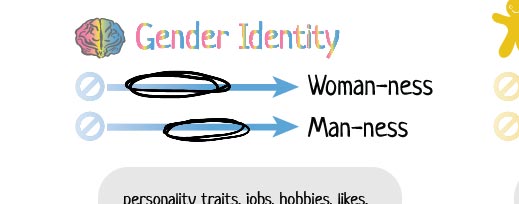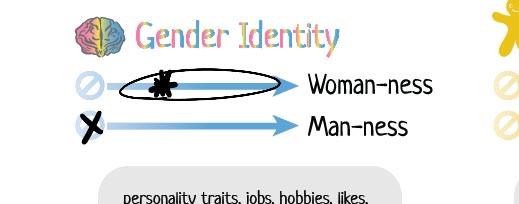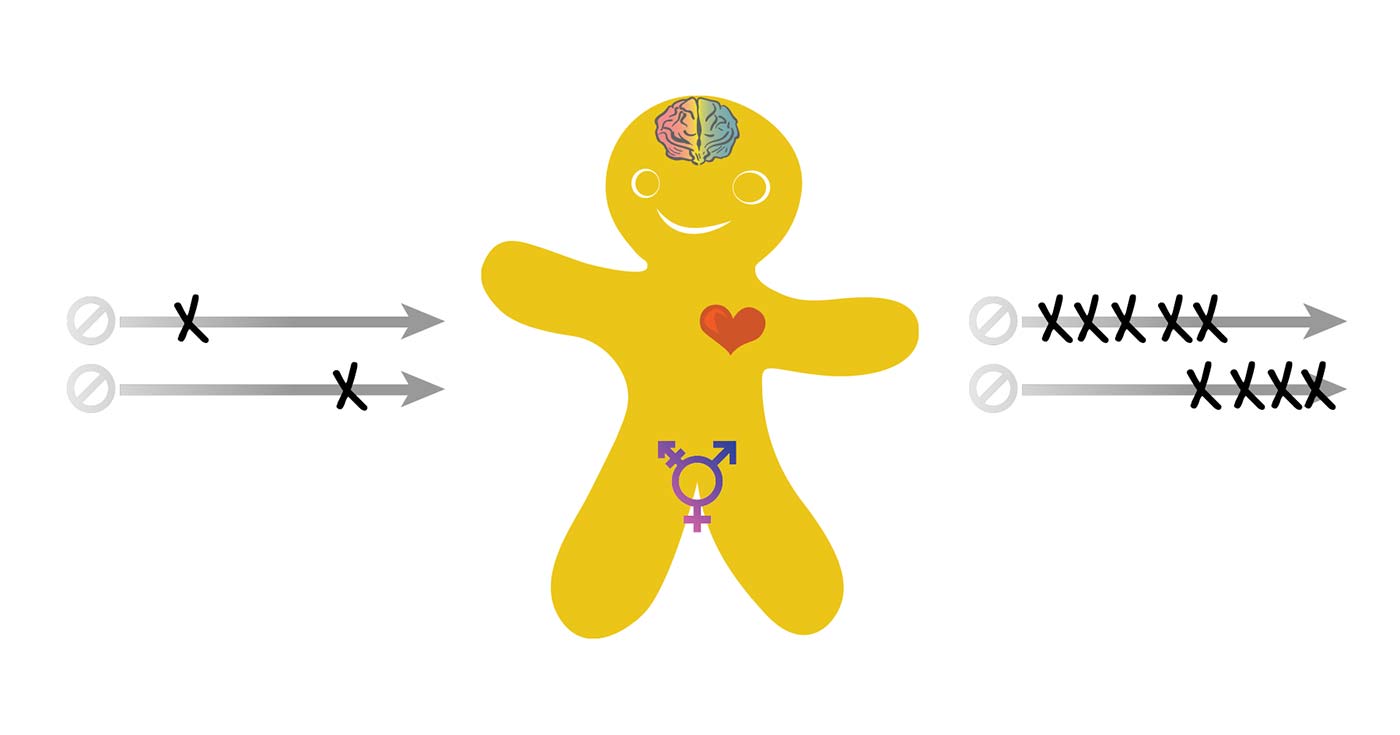I got an email pointing out to me that my versions of the Genderbread Person exclude genderfluid people. And not just people who use the term “genderfluid” to identify themselves, but anyone who expresses gender differently at different times. So, do they? Let’s figure it out.
First, I want to say what I pretty much always say when I get asked a question about Genderbread: it’s not perfect, and it’s a forever work in progress. That’s why I’ve released so many different versions, all based on wonderful insight and pointed constructive criticism like this question. I addressed this in my Nerd Nite Talk “Gender: From Boxes to -Ness."
So nothing that follows is my trying to say this model can’t be improved, or doesn’t have issues. It can and it does. That’s what we’re doing here!
Okay, so wrapped cozily in that weighted blanket caveat, does the Genderbread Person exclude genderfluid people? Or not make room for gender fluidity in general?
I don’t think so.
Here’s why:
The Genderbread Person is a tool for helping ourselves and others understand gender – both our own, others’, and gender in general. Like any tool, it’s efficacy is really dependent upon how well you use it.
Just because you’ve only used a hammer for building, doesn’t mean it’s not great at dismantling. That’s what those little claws on the back are for.
Now, of course, the Genderbread Person, like any other tool, has its limitations.
For example, the Genderbread Person is not a great tool for depicting comprehensive sexuality (that’s why we have the Sexualitree).
Try as you might, a hammer is never good for screwing. That’s why we have screwdrivers.
However, it is well-suited to include and depict genderfuid people and gender fluidity, if you use it right.
The problem, in this case, isn’t the tool itself, but the ways a lot of people might be using it. And what is the “right” way to use the tool in this case?
Well, you just have to have two things in mind if you’re using Genderbread to describe yourself, or include bits of instructions when you’re using it with others:
1. You’re not limited to a single dot.
You are invited to see yourself as existing anywhere along any of the continua (or scales). Including (and especially!) in multiple places!
For example, on the gender identity scales, you might see yourself as existing between the roughly 20% point and 60% point of “woman-ness” and 40% point and 80% point on the “man-ness.”

Those ranges being the wiggle room for the fluidity you notice in your experience of gender. (Sidebar: if that’s actually how you see yourself, we should be friends, because ditto: that’s how I’d plot my Genderbread 😘)
Or maybe you’re a firm 0% on man-ness, but identify with different amounts of woman-ness depending on your situation.
Here’s how a friend of mine plots their gender identity scales, to describe themself as above – a “genderfluid femme” way of doodling gender:

Drawing ranges (e.g., with circles, brackets, or lines) are one of the ways you can represent fluidity on the Genderbread scales (btw: not just on Identity, but also on the Expression, Sex, and Attraction scales). But it’s not the only way.
For example, I’ve seen other people in workshops use different letters (instead of a dot or a star or asterisk) to represent the different ways they experience things based on different situations. Like an “F” for “around family,” an “M” for “me, by myself,” and an “S” for “in society.” This method highlights the fluidity of how being around other people, or in certain situations, can affect how we experience gender.
And the list goes on. These examples aren’t meant to be exhaustive, or even clear “Do it this way” instructions, but meant to highlight the broader point I made above:
If you’re not just limiting yourself to one dot on each continuum, the Genderbread Person is a great starting place for understanding and depicting gender fluidity.
Now, on to the other point.
2. Your place on the scales can change.
However you see yourself in regards to the Genderbread scales of Identity, Expression, Sex, and Attraction right now – today, in this exact moment – isn’t set in stone. If you doodled yourself into that diagram again in the future, it’s totally okay if your answers change. And they most likely will!
This hits at the more long-term time frame aspect of gender fluidity, and also at the societal evolution of gender itself.
A lot of people think that filling out the Genderbread Person is like filling in a birth certificate: it’s a one-time thing. Well, it’s not a one-time thing.
You’re welcome to update how you see yourself based on how you’ve changed, or how society has changed, or how you haven’t really changed but you just finally see yourself for who you are – however often as you like!
Revisit the Genderbread, and your Genderbread, as often as you’d like. I always smile when I hear from people – in workshops or via replies on this site – that how they’ve seen themselves in the scales of the Genderbread Person has changed since last time they considered it.
You’re not doing it wrong if it changes, or if you’re not sure if how you see yourself now will represent how you see yourself in the future.
Like Bryce Maryott commented on Facebook, “I’ve always thought that the markings should be done in pencil because (in my experience) they change over your lifetime anyway.”
The Genderbread Person is best filled in with pencil – literally or metaphorically.
So maybe it is just like a birth certificate*: you can update it later if you realize the scribbles that were scribbled don’t do a good job of representing who you really are.
(*This parallel is true in many countries and states, and generally true as a “should” – it should be this way with birth certificates)
Creativity is encouraged.
Take your marker out and have fun. Blot out things that don’t apply for you, and draw in the things you need to better show up. Color outside the lines.
This is as much a statement about gender in general, as a suggestion for how to use the Genderbread Person as a tool.
And, of course, this applies directly to using Genderbread to represent and understand genderfluid experiences, identities, expressions, and more.
I don’t think that, if you’re following the above rules (or, more importantly, not adding restrictive rules that need not be added), the Genderbread Person is inherently exclusive of gender fluidity. It’s not a hammer trying to be a screwdriver in this regard.
But maybe I’m wrong.
If, after reading this, you still think the Genderbread Person isn’t inclusive of genderfluid people, please let me know! And share your ideas for how it can be improved. That’s what the reply button is for.


